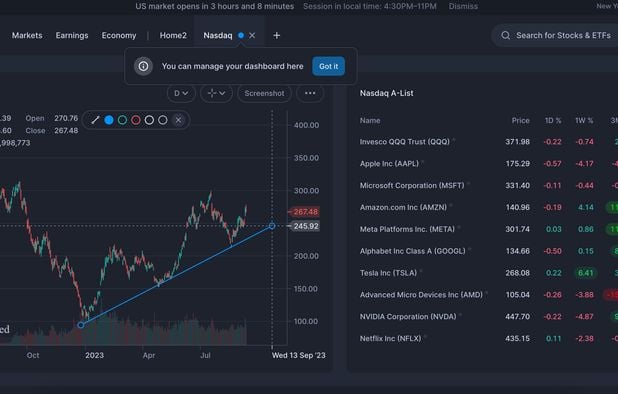When selecting a platform that utilizes AI to forecast or analyze stocks Customer support is a crucial aspect. Support that is prompt and reliable will make all the difference when it comes time to address issues, optimize utilization of the platform, create an efficient trading environment and more. These are the top 10 tips for evaluating the customer service provided by these platforms.
1. Evaluate Support Availability
24/7 support: Find out if the platform has 24/7 assistance, which is especially crucial for global market and real-time trade.
Hours of operation: If 24 hour support isn't available, ensure that support is accessible during your business hours.
Holiday coverage: Make sure to see if you are able to get support on weekends, holidays, and market closures.
2. Test Response Times
Initial response. Contact customer support and ask them a sample question to see how quickly they respond.
Resolution time: Decide the time frame you will need to resolve problems before they can be solved, and don't simply acknowledge that they exist.
Live chat: Check the responsiveness and effectiveness of the live chat feature.
3. Examine Options for Support
Multiple channels: Check that the platform can handle multiple channels, like live chat, email, telephone, social media, etc.
Check that your preferred support channel is solid.
Self-service options: Look for a comprehensive knowledge base, FAQs, or community forums for quick problem-solving.
4. Evaluate the Support Quality
Expertise: Support agents must be familiar with the platform and trading issues.
Problem-solving: Evaluate whether support agents can effectively resolve difficult issues or escalate them appropriately.
Professionalism. Check that support interactions were professional, courteous, efficient.
5. Make sure you have a dedicated account manager
Support Premium: Verify if institutions or higher-tiered plans are able to access account managers.
Find out if your account manager provides tailored support and proactive guidance.
Relationship building: Ensure that your account managers are in contact and establish long-term relationships.
Check the Documentation Help
Knowledge base. Ensure that the platform has a well-organized searchable database of tutorials, guides and tips on troubleshooting.
Video tutorials See if you are able to find videos on the platform.
API documentation. API documents are important for developers.
7. Evaluation of Peer and Community Support
Forums for users - Check to see if the platform provides a forum or a community where users can discuss strategies and exchange solutions.
Social media forums - Look for groups that are not official Facebook, LinkedIn, Reddit and other social media websites in which users debate the various platforms.
Community engagement: Make sure that the team of the platform is actively involved in the forums and discussions of the community.
8. Evaluate Escalation Processes
Issue escalation - Make sure that there's a defined procedure for elevating unresolved concerns to higher management or support levels.
Follow-up - See if the support team continues to follow up with you after you've fixed the issue.
Feedback loop: Ensure that the platform is gathering feedback from its users in order to enhance its support offerings.
9. Test Support during Critical Conditions
Market volatility: Call support during times of high volatility to determine their sensitivity under pressure.
Technical Issues: Try to simulate the issue (e.g. login issues or data discrepancy), to see how the support staff handles the issue.
Trade execution: Check whether you can receive support for urgent issues relating to trade (e.g. failed orders or delays in execution).
Review of User Feedback from Reviews
Reviews on the internet: Read user reviews of platforms like copyright, G2, and Reddit in order to determine general satisfaction.
Testimonials and Case Studies: Search for testimonials or studies highlighting the positive experiences of customers.
Check the platform to see how they handle complaints, negative feedback and support.
Bonus Tips
Support during trial time: You can test the capabilities of the platform by using the demo or trial period.
Support for your language If English is not your first language, it is best to check to see if English is supported.
Training and onboarding - Check to see if the platform offers onboarding or training sessions to help users start their journey.
With these suggestions, you can effectively assess the level of customer service offered by AI stock predicting/analyzing trading platforms Make sure you choose an option that is reliable, responsive and helpful support. A platform that offers strong customer support can enhance your experience and allow you to get the most out of the features it offers. Take a look at the best ai stock trading bot free url for website advice including ai stock market, ai for investment, ai trade, ai investment app, ai stocks, investing ai, ai stock trading app, investment ai, ai stocks, incite and more.

Top 10 Tips For Evaluating The Scalability Ai Stock Predicting/Analyzing Trading Platforms
It is essential to determine the performance and scalability of AI-driven trading and stock prediction platforms. This will guarantee that they're able to cope with the increasing volume of data as well as market complexity and user demands. Here are 10 suggestions for evaluating the scaleability.
1. Evaluate Data Handling Capacity
TIP: Make sure that the platform you're considering can process and analyze large datasets.
The reason: Scalable platforms need to handle growing data volumes without performance degradation.
2. Real-time testing of processing capabilities
See how the platform handles live data streams such as stock prices and breaking news.
Why: The real-time analysis of trading decisions is vital since delays can cause you to miss opportunities.
3. Cloud Infrastructure and Elasticity Cloud Infrastructure and Elasticity: Take a look
Tips: Determine whether the platform is able to dynamically scale resources and utilizes cloud infrastructure (e.g. AWS Cloud, Google Cloud, Azure).
Cloud-based platforms are a great way to gain the flexibility. They allow the system to be scaled up and down according to demand.
4. Algorithm Efficiency
TIP: Check the computational efficacy (e.g. deep-learning or reinforcement learning) of the AI models used for prediction.
Why? Complex algorithms may require a lot of resources. Optimizing them so that they make them scalable is important.
5. Learn more about Parallel Processing and Distributed Computer Systems.
TIP: Check if the platform is able to use distributed computing and parallel processing frameworks.
Why: These technologies enable faster data processing and analysis over a variety of nodes.
Examine API Integration. API Integration.
Tip : Make sure your platform integrates with other APIs, such as market data providers or brokerage APIs.
The reason: seamless integration means the platform can adapt to the latest information sources and environments for trading.
7. Analyze User Load Handling
Tip: Simulate the impact of high users to gauge how the platform performs under stress.
The reason: A platform that is scalable must be able to maintain its performance as the number of users increases.
8. Evaluation of Model Retraining and Adaptability
TIP: Check how often AI models can be trained on new data.
Why? Markets are constantly changing, and models need to evolve quickly to remain precise.
9. Check for Fault Tolerance & Redundancy
Tips. Check that your platform is equipped with failover systems and redundancy in case of hardware or software problems.
The reason: Since downtime is costly when trading and trading, fault tolerance is essential to scalability.
10. Monitor Cost Efficiency
Tip: Consider the cost of scaling your platform. Consider cloud resources like storage for data and computing power.
Why? Scalability should come at a cost that is affordable. This means that you must balance performance against expense.
Bonus Tip: Future-proofing
Check that the platform supports the latest technologies (e.g. quantum computing and advanced NLP), and can adapt to changes in the regulatory environment.
If you focus on these factors you will be able to assess the scale of AI stock prediction and trading platforms. This will ensure they're robust, effective, and ready for future expansion. Read the top rated continue reading on how to use ai for copyright trading for site recommendations including stock trading ai, ai stock prediction, how to use ai for copyright trading, ai in stock market, stocks ai, stock trading ai, investing with ai, chart ai trading, ai options trading, ai stock predictions and more.
